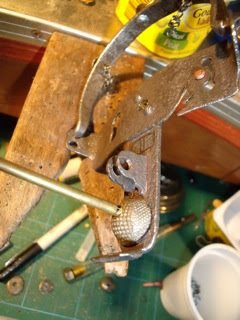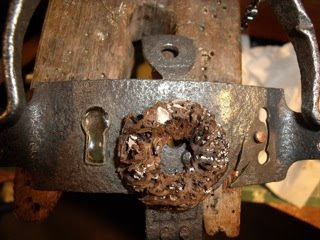 The kiln reveals my tiny glass lenses, fused to the steel strap.
The kiln reveals my tiny glass lenses, fused to the steel strap. Left, a drawer-pull as it was originally, right the result of two fuse firings.
Left, a drawer-pull as it was originally, right the result of two fuse firings. Top of a 150-year-old thimble getting tube-riveted into place.
Top of a 150-year-old thimble getting tube-riveted into place.
 Laying the lens in place where it is to go. The tab of the lens has been riveted into place on the trap, but it acts as a pivot point, so it will be chained into place from above.
Laying the lens in place where it is to go. The tab of the lens has been riveted into place on the trap, but it acts as a pivot point, so it will be chained into place from above. Creating the object to be viewed through that lens: a sawn-down piece of seaweed roots, with tiny shell fragments still embedded, will become the organic center of the piece.
Creating the object to be viewed through that lens: a sawn-down piece of seaweed roots, with tiny shell fragments still embedded, will become the organic center of the piece. The lens gets attached in four places with the tiny chain.
The lens gets attached in four places with the tiny chain. The drawer pull, now in place, will need to be suspended from the iron jaw above, so time to modify those parts to make that happen.
The drawer pull, now in place, will need to be suspended from the iron jaw above, so time to modify those parts to make that happen. The drawer-pull ready to be drilled
The drawer-pull ready to be drilled with a tiny pin drill and miniature bit.
with a tiny pin drill and miniature bit. The steel jaw gets similar treatment, this time with a flex-shaft tool behind the bit.
The steel jaw gets similar treatment, this time with a flex-shaft tool behind the bit. Having finished with the metal manipulation of the trap, I can attach the more delicate materials with less fear of damaging them. The keyhole first, with glass fused into it...
Having finished with the metal manipulation of the trap, I can attach the more delicate materials with less fear of damaging them. The keyhole first, with glass fused into it... The keyhole as it will be seen from the front.
The keyhole as it will be seen from the front. A pearl to live in back.
A pearl to live in back. Removing an eye for the central opening in the root ball.
Removing an eye for the central opening in the root ball. And put in place.
And put in place. Which leaves me safe to attach the lens permanently, as well as the little drawer-pull above. Now the structure is coming together.
Which leaves me safe to attach the lens permanently, as well as the little drawer-pull above. Now the structure is coming together. Hand-drawing the text for the title into some asphaltum resist, which will then be etched into the nickel-silver bar.
Hand-drawing the text for the title into some asphaltum resist, which will then be etched into the nickel-silver bar.
 While it's etching, I can move on to the cord.
While it's etching, I can move on to the cord.


 Creating the clasp.
Creating the clasp. The hanging mechanism, complete.
The hanging mechanism, complete. The etched title bar is shaped,
The etched title bar is shaped, and elements are created for it. Here I've taken two antique earnuts and some fine steel wire.
and elements are created for it. Here I've taken two antique earnuts and some fine steel wire. The whole assembly soldered together.
The whole assembly soldered together.
 Creating the hanging element for the title bar completes the piece.
Creating the hanging element for the title bar completes the piece. The neckpiece hung on my 'just finished' hook, awaiting its studio photo session.
The neckpiece hung on my 'just finished' hook, awaiting its studio photo session.************************
The finished images of 'Two Sides of History' can be viewed here.
Or, for the person who simply can't live another day without owning it (there's only one out there!), you might prefer to check it out here.
At the time of writing this, I'm deep into a new neckpiece that will be posted here next week after my teaching weekend in Melbourne.
Thanks for visiting. Ciao!




























